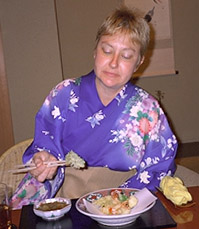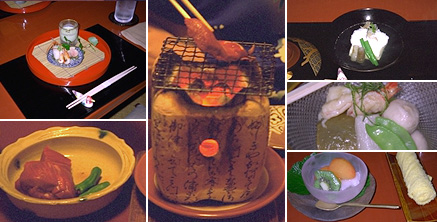
Bruce "Tog" Tognazzini.
|
|
Japan on $1000 per Day
Day 14: We Find our Summer HouseExpecting to pick up a nice little summer cottage for a song, we taxied out to Kinkaku–ji, the Temple of the Golden Pavilion, the retirement home of the late Shogun, Yoshimitsu, who passed away just last 1400-something. We were more than disappointed to find that this modest little hideaway is not on the market.
The temple itself is built out over the water and seems to float above in gold-leafed serenity. It was "restored to its original splendor" in 1987, leaving it entirely too gold, and too splendorous. Give it 20 years or so to develop a bit of dirt and it will once again look as gorgeous as its pictures that often grace the front covers of books about Kyoto and even Japan. The gardens display that quiet beauty and grace that are the hallmarks of zen. Were you to see but one site in all of Japan, you could do no better than to come here. After far too short a time, we dragged ourselves away from the temple gardens; we had work to do! We had planned out in meticulous detail a circuitous route across the breadth of Kyoto that would lead us to the best values on each of a variety of items we intended to bring home as gifts. However, we never even got started. Given the heat and our flagging health in the wake of yesterday's disastrous luncheon, we abandoned said plans and had our driver proceed to the nearest Gaijin Gift Emporium. Our particular tourist haven turned out to be a seven-story building with English-speaking Japanese proprietors willing to part with dubious merchandise at outrageous prices. After trading in what was left of our bank account for what later proved to be $24 worth of beads and trinkets, we were off to the Big Finish, Tawara-ya. Tawara-ya A few years ago, Better Homes and Gardens joined a host of other publications in declaring the 19-room Tawara–ya Ryokan (country inn) the finest hotel in the world. Other publications disagree, believing the Hiragiya Ryokan, directly across the street and sporting remote-controlled curtains, to be the finest in the world. No matter, they are both more than adequate. Tawara-ya was founded in the 1700’s, but burned to the ground 175 years ago. As a result, the rooms are rather new, with that typical 1820’s look. Ours was one of the cheaper ones, a mere $500 per night per person, double-occupancy, and yet it sported its own private corner of the garden, along with a sitting room, in addition to the 8-tatami main room. At first glance, the place seemed zero tech, with the exception of a telephone that harked back to the 1930s. But behind a sliding panel lurked a TV. (No VCR, no "special" videos. This hotel hosts too many gaijin (foreigners) who might object.) Another panel in the dressing room revealed a hair drier. In the toilet room was a high-tech toilet similar to the one we had on order back in Tokyo, complete with washing and drying functions. The bath was private, with its own little garden. It had been filled several hours before, allowing the wooden walls of the tub to capture and hold the heat. Wooden covers kept it warm through the day and the night. When we took a second bath the next morning, we had only to top it off with perhaps an inch of hot water to restore it to its original temperature. (I think we actually took three baths, total. When you’re paying $1000 a day for a hotel room, you have to work hard to amortize it.)
We were faced with a quandary: How to not eat and yet not get caught not eating. Time to harken back to the time-honored techniques of childhood. Every time the maid would leave the room, we would run around hiding food. The tofu can probably still be found behind the TV set. We stuck the fish in with the wet towels, and it left with the wash. I'm sure they never caught on. Fortunately, things settled down. The Finest Hotel in the World knew they were dealing with gaijin and, after this smallest hint of seasonal Kyoto fare, they switched over to a good old fashioned American Japanese dinner: Shrimp Tempura and Beef Teriyaki. I would normally have been quite hurt that they robbed us of the True Kyoto Experience by treating us like a couple of foreign yokels, but in this case, I could have kissed them. The shrimp and veggies were delicious, and the beef teriyaki was no ordinary beef teriyaki: Not only did it arrive raw, for us to cook over our own personal barbecues filled with hot coals, it was Kobe beef, the finest in the world. We spent a pleasant night and were greeted in the morning by a scrumptious American breakfast. All-in-all, it was a marvelous experience. The next time we return to Kyoto, we will stay at the even more expensive Hiragiya, across the street just to see if anything could be more luxurious. Paradoxically, however, this was not our favorite night in Japan. That honor remained with the Kinkikan Ryokan, in Takama, as chronicled in Day 8 of this adventure. The Kinkikan, while less luxurious, was somehow more real and, at just a little over half the price of the Tawara–ya, it was as close to a value as you are likely to find in $500+ Japanese hotel rooms. (With today's lower value of the Yen, the Kinkikan now approaches affordability. ) The more expensive Kyoto experience was also one of total isolation; there they strive hard to create the illusion that you are the one and only guest of the hotel. The Kinkikan, with its (gender-separated) communal baths and common breakfast room, gave us a chance to get to know some real Japanese. With our Kyoto experience behind us, we are off on the bullet train to Tokyo and an unexpected, but informative lesson in design, training, and documentation: Construct and communicate the big concepts well and users will grasp the details on their own. Ignore the big concept and users will hopelessly flounder. The subject of this lesson lay in the conceptual model of Tokyo streets, streets that are entirely without names, numbers, or other identifiers, yet lined with houses are easily found—as long as you know the trick, that big concept of which I spoke. Previously: Day 13: Doom Next month: Planes, Trains, and Toilet Seats |


